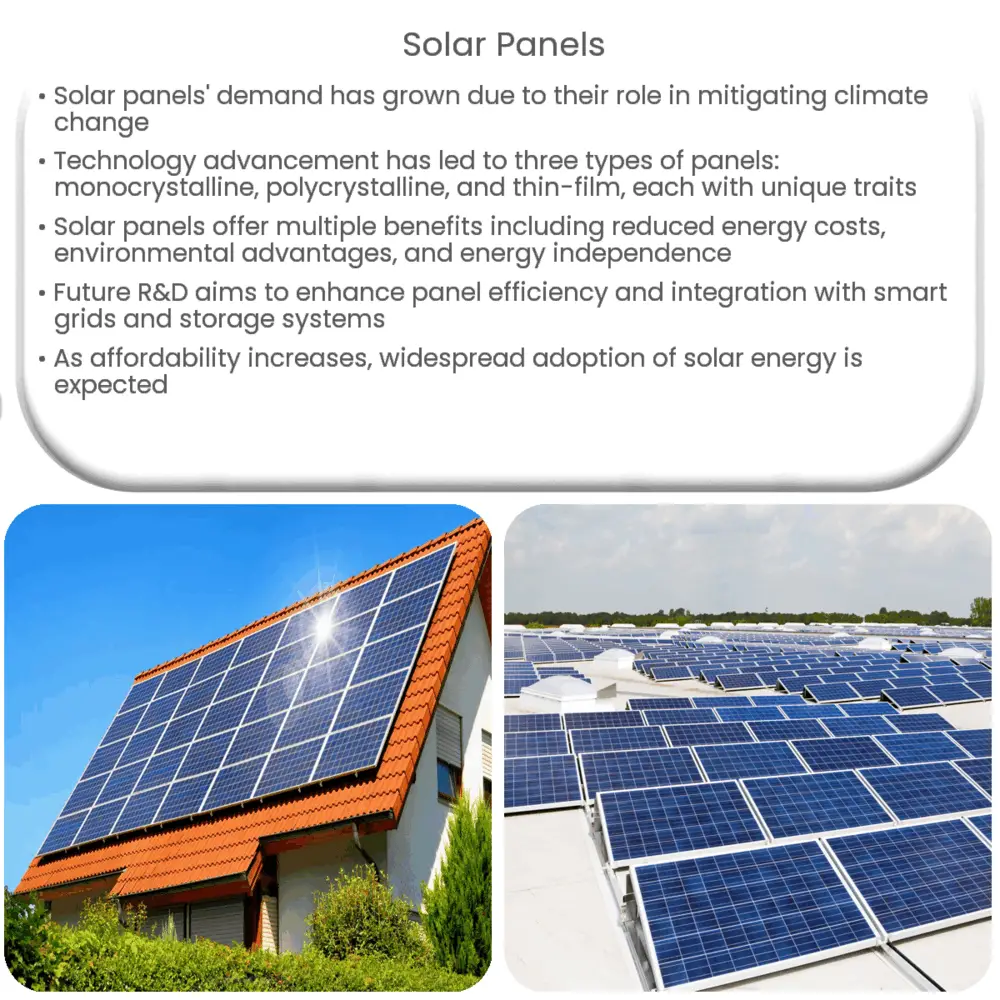Discover the history, types, and advantages of solar panels, their role in sustainable energy, and how they contribute to a greener future.

Solar Panels: Harnessing the Power of the Sun
Introduction
Solar panels have become an increasingly popular and essential source of renewable energy in the global effort to combat climate change and reduce our reliance on fossil fuels. As more and more people become aware of the environmental and economic benefits of solar energy, the demand for solar panels has grown rapidly. In this article, we will explore the history, types, and advantages of solar panels, as well as their role in the future of sustainable energy.
A Brief History of Solar Panels
The history of solar panels dates back to the early 19th century when French physicist Alexandre Edmond Becquerel first discovered the photovoltaic effect in 1839. This groundbreaking discovery demonstrated that certain materials could generate an electric current when exposed to sunlight. In 1954, scientists at Bell Laboratories developed the first functional solar cell, which converted sunlight into electricity with an efficiency of about 6%. Since then, the technology has advanced exponentially, with modern solar panels reaching efficiencies of up to 22%.
Types of Solar Panels
There are three main types of solar panels: monocrystalline, polycrystalline, and thin-film. Each type has its unique characteristics and advantages.
1. Monocrystalline Solar Panels
Monocrystalline solar panels are made from a single crystal structure of silicon. They are known for their high efficiency and sleek appearance, thanks to their uniform black color. However, they can be more expensive than other types of solar panels.
2. Polycrystalline Solar Panels
Polycrystalline solar panels are made from multiple silicon crystal fragments that have been melted together. They have a characteristic blue hue and are generally less efficient than monocrystalline panels, but they are also less expensive.
3. Thin-Film Solar Panels
Thin-film solar panels are made by depositing a thin layer of photovoltaic material onto a substrate. These panels can be flexible, lightweight, and aesthetically pleasing, making them suitable for a variety of applications. However, they typically have lower efficiency and a shorter lifespan compared to monocrystalline and polycrystalline panels.
Advantages of Solar Panels
There are several advantages to using solar panels as a renewable energy source, including:
- Environmental benefits: Solar energy is a clean and sustainable source of power, producing no greenhouse gas emissions or air pollution.
- Reduced energy costs: By generating electricity on-site, homeowners and businesses can significantly reduce their reliance on grid-supplied power and save on energy bills.
- Energy independence: Solar panels provide a measure of energy security by reducing dependence on imported fossil fuels and exposure to volatile energy prices.
- Low maintenance: Solar panels require minimal maintenance, with most systems only needing an occasional cleaning to maintain optimal performance.
The Role of Solar Panels in the Future of Sustainable Energy
As the world shifts towards a more sustainable and eco-friendly energy infrastructure, solar panels are expected to play a crucial role in the transition. The ongoing advancements in solar panel technology, combined with government incentives and public awareness, are driving the adoption of solar energy on a global scale.
Increased Efficiency and Affordability
Research and development in the solar industry have led to significant improvements in the efficiency and cost of solar panels. As technology advances, we can expect even higher efficiency rates and lower costs, making solar energy accessible to a broader range of consumers and markets.
Integration with Smart Grids and Energy Storage
One of the challenges of solar energy is its intermittent nature, as it depends on sunlight availability. To address this issue, solar panels can be integrated with smart grids and energy storage systems, such as batteries. This allows for the storage of excess energy during peak sunlight hours and its release during periods of low sunlight or at night, ensuring a stable and continuous energy supply.
Widespread Adoption and Grid Parity
As solar energy becomes more affordable and accessible, its adoption is expected to increase across various sectors, including residential, commercial, and industrial applications. Furthermore, solar energy is approaching grid parity in many regions, meaning the cost of generating electricity from solar panels is becoming competitive with traditional energy sources like fossil fuels. This trend will likely continue as solar technology improves and economies of scale drive down costs.
Conclusion
Solar panels represent a promising solution in the ongoing quest for sustainable and renewable energy sources. With advancements in technology, increased affordability, and a growing awareness of the need for eco-friendly energy options, solar panels are set to play a vital role in shaping the future of our energy infrastructure. As we continue to develop and optimize solar panel technology, we can look forward to a cleaner, greener, and more sustainable future for generations to come.

